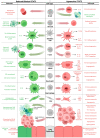Cell Type-Specific Roles of STAT3 Signaling in the Pathogenesis and Progression of K-ras Mutant Lung Adenocarcinoma
- PMID: 35406557
- PMCID: PMC8997152
- DOI: 10.3390/cancers14071785
Cell Type-Specific Roles of STAT3 Signaling in the Pathogenesis and Progression of K-ras Mutant Lung Adenocarcinoma
Abstract
Worldwide, lung cancer, particularly K-ras mutant lung adenocarcinoma (KM-LUAD), is the leading cause of cancer mortality because of its high incidence and low cure rate. To treat and prevent KM-LUAD, there is an urgent unmet need for alternative strategies targeting downstream effectors of K-ras and/or its cooperating pathways. Tumor-promoting inflammation, an enabling hallmark of cancer, strongly participates in the development and progression of KM-LUAD. However, our knowledge of the dynamic inflammatory mechanisms, immunomodulatory pathways, and cell-specific molecular signals mediating K-ras-induced lung tumorigenesis is substantially deficient. Nevertheless, within this signaling complexity, an inflammatory pathway is emerging as a druggable target: signal transducer and activator of transcription 3 (STAT3). Here, we review the cell type-specific functions of STAT3 in the pathogenesis and progression of KM-LUAD that could serve as a new target for personalized preventive and therapeutic intervention for this intractable form of lung cancer.
Keywords: K-ras; STAT3; TME; lung adenocarcinoma; mucosal immunology; myeloid; tumor-promoting inflammation.
Conflict of interest statement
The authors declare no conflict of interest.
Figures
Similar articles
-
Sex specific function of epithelial STAT3 signaling in pathogenesis of K-ras mutant lung cancer.Nat Commun. 2018 Nov 2;9(1):4589. doi: 10.1038/s41467-018-07042-y. Nat Commun. 2018. PMID: 30389925 Free PMC article.
-
IL6 Blockade Reprograms the Lung Tumor Microenvironment to Limit the Development and Progression of K-ras-Mutant Lung Cancer.Cancer Res. 2016 Jun 1;76(11):3189-99. doi: 10.1158/0008-5472.CAN-15-2840. Epub 2016 Apr 1. Cancer Res. 2016. PMID: 27197187 Free PMC article.
-
Glucose-6-phosphate dehydrogenase promotes the proliferation and migration of lung adenocarcinoma cells via the STAT3 signaling pathway.J Mol Histol. 2022 Apr;53(2):215-225. doi: 10.1007/s10735-021-10045-7. Epub 2022 Jan 14. J Mol Histol. 2022. PMID: 35028787
-
STAT3: Versatile Functions in Non-Small Cell Lung Cancer.Cancers (Basel). 2020 Apr 29;12(5):1107. doi: 10.3390/cancers12051107. Cancers (Basel). 2020. PMID: 32365499 Free PMC article. Review.
-
Understanding the Complexity of the Tumor Microenvironment in K-ras Mutant Lung Cancer: Finding an Alternative Path to Prevention and Treatment.Front Oncol. 2020 Jan 22;9:1556. doi: 10.3389/fonc.2019.01556. eCollection 2019. Front Oncol. 2020. PMID: 32039025 Free PMC article. Review.
Cited by
-
Immunosuppression of Tumor-Derived Factors Modulated Neutrophils in Upper Tract Urothelial Carcinoma Through Upregulation of Arginase-1 via ApoA1-STAT3 Axis.Cells. 2025 Apr 30;14(9):660. doi: 10.3390/cells14090660. Cells. 2025. PMID: 40358184 Free PMC article.
-
Selective inhibition of canonical STAT3 signaling suppresses K-ras mutant lung tumorigenesis and reinvigorates anti-tumor immunity.Front Immunol. 2025 Apr 28;16:1575181. doi: 10.3389/fimmu.2025.1575181. eCollection 2025. Front Immunol. 2025. PMID: 40356899 Free PMC article.
-
From targeted therapy to a novel way: Immunogenic cell death in lung cancer.Front Med (Lausanne). 2022 Dec 23;9:1102550. doi: 10.3389/fmed.2022.1102550. eCollection 2022. Front Med (Lausanne). 2022. PMID: 36619616 Free PMC article. Review.
References
Publication types
Grants and funding
LinkOut - more resources
Full Text Sources
Miscellaneous



